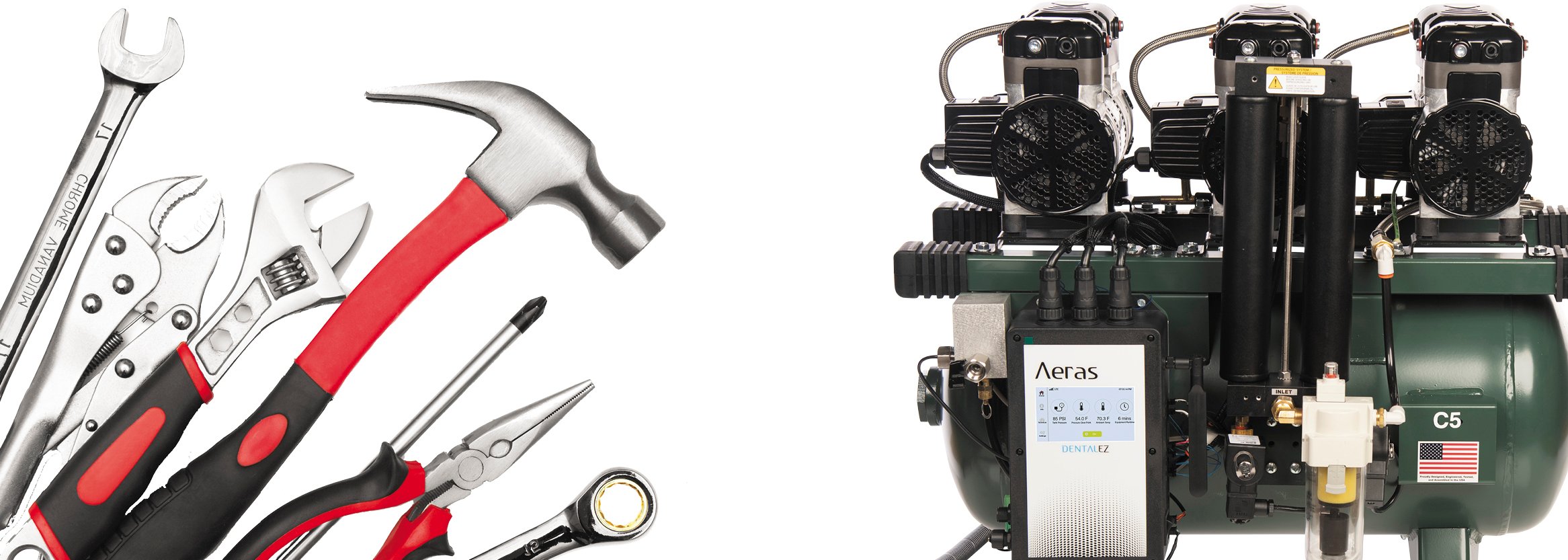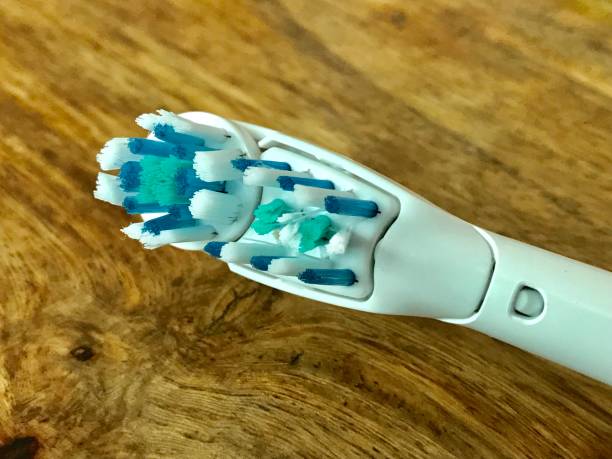Your utility room is the heart of your dental practice. Contained within this often cramped and noisy space are the dental air compressor, which powers your dental handpieces, and the dental vacuum pump, which runs the high-volume evacuators (HVEs) and saliva ejectors (SEs). Utility room equipment must be reliable; if an issue causes your dental vacuum or air compressor to go down, your entire practice can be brought to a standstill.
In this article, we will discuss why preventative maintenance of your utility room equipment is important and review checklists and timelines for effective maintenance protocols for dental air compressors and vacuum pumps.
TIP: For detailed explanations of how dental vacuums and air compressors work, check out these guides:
Why Preventative Maintenance is Helpful for Dental Vacuums & Air Compressors
Regular maintenance for dental vacuum pumps and dental air compressors is vital for several reasons, all of which contribute to your reputation and your bottom line:
- The health and safety of patients and staff
- Getting the best daily performance out of your equipment
- Extending the lifespan of your equipment
Safety
Without regular maintenance, dental vacuum lines can become narrowed or blocked by debris and contaminated with biofilm, causing health risks to patients and staff. A recent article in RDH Magazine warns of potential cross-contamination between patients as a major driver necessitating daily maintenance of evacuation lines. A 2017 article promoting the use of HVEs describes how two hygienists who likely contracted a serious virus due to insufficient equipment and clogged vacuum pump lines had to miss work during a month-long recovery. And since the COVID-19 pandemic has had an outsized impact on clinical environments, dental vacuum pumps now play an even greater role in keeping your operatory environment clean, making consistent maintenance especially important.
TIP: Our 2021 Guide to Aerosol Mitigation discusses in detail how HVEs and dental vacuums can help keep practitioners and patients safe in a pandemic.
Performance & Longevity
Like an automobile engine, which requires regular replacement of oil and filters to have a long, dependable life, dental vacuum pumps and dental air compressors need regular maintenance to perform at their best. Consistent care of your equipment minimizes problems and safeguards longevity, saving you money in the long run.
For DENTALEZ by Ramvac utility equipment, regular preventative maintenance will help you achieve the following life expectancies:
* In in-house testing, these models ran for 60,000 continuous hours, at which time the testing was concluded. With an average practice running its dental vacuum about 2,000 hours per year, that test exceeded the equivalent of more than 30 years in service. In fact, there are Ramvac Bulldog and Bison units currently operating in the field that are more than 30 years old.
Who Performs Equipment Maintenance and How Often?
The responsibility for maintaining dental air compressors and dental vacuums depends on factors like the size and location of your practice or the complexity of the maintenance tasks, but typically falls to some combination of dentists and their staff, dental equipment dealer technicians, and sometimes even sales support team members.
TIP: Ask your dealer technician for advice when choosing utility room equipment. Since they get to know the strengths and weaknesses of many brands, they know what models are reliable and will last a long time!
A leader in your practice should work with your equipment dealer tech to put together a written maintenance protocol for all dental equipment. It should include all the tasks required at various time intervals—such as before or after every patient, daily, weekly, monthly and annual tasks—and should be posted where everyone can see it. Our recently published Guide to Dental Handpiece Maintenance discusses the importance of establishing a regular routine, training staff and posting reminders to ensure adherence.
Dentists and staff members should also be trained to check utility room equipment for indications that maintenance is due. Aeras smart technology built into our newer dry vacuums and compressors sends notifications via text or email to staff and/or technicians when service may be required. For example, Aeras may send a message that vacuum strength readings or temperatures on the dental vacuum pump are out of normal range, prompting you or a staff member to check the machine and/or user manual and nician.
For non-Aeras machines, you should note how they sound and “feel” when they are working properly, so that if a weak vacuum strength or an unusual noise occurs, you or a staff member can recognize it and check for indications that maintenance is required.
Recommended Maintenance for Dental Vacuums
Dry Vacuums (Aeras & Badger LF™)
Oiled Aeras Dry Vacuum
See the Aeras Dry Vacuum User Manual or one-page Maintenance Chart for detailed instructions on how to perform maintenance tasks.
| Maintenance Task | Timing |
| ● Flush the lines from each operatory with hot water and a DENTALEZ-recommended cleaner, such as SlugBuster™ * | Daily
Note: If doing surgical procedures, disinfect the vacuum lines with cold water after each patient |
| ● Check oil drip rate | First week, then every 6 months or 1,000 hours* and after every oil change |
| ● Inspect air filters
● Wipe down the machine |
Every 6 months or 1,000 hours † |
| ● Replace the oil
● Replace the air filters ● Inspect/replace oil filter element ● Inspect/replace (if damaged) the V-belt (drive belt) |
Annually or every 2,000 hours †
|
| ● Replace the V-belt (drive belt) | Every 5-6 years or every 12,000 hours |
* Please note: Use only non-foaming cleaners. Foaming cleaners should not be used. Foam in the dry vac can lead to damaging the pump and will void the warranty.
† The Aeras control panel will display the number of hours (remaining runtime) before each maintenance task is due.
Oilless Badger LF Dry Vacuum
See the Badger LF User Manual for detailed instructions on how to perform maintenance tasks.
| Maintenance Task | Timing |
| ● Flush the lines from each operatory with hot water and a DENTALEZ-recommended cleaner, such as SlugBuster™ * | Daily
Note: If doing surgical procedures, disinfect the vacuum lines with cold water after each patient |
| ● Inspect air filters
● Inspect pump head exchange ● Wipe down the machine |
Every 6 months or 1,000 hours † |
| ● Replace the air filters
● Inspect/replace (if damaged) the Poly |
Annually or every 2,000 hours †
|
* Please note: Use only non-foaming cleaners. Foaming cleaners should not be used. Foam in the dry vac can lead to damaging the pump and will void the warranty.
† The Maintenance LED on the control panel will illuminate every 1,000 hours. To reset Maintenance LED after maintenance has been performed, press and hold the Reset button for 10 seconds until the Maintenance LED begins blinking.
Wet Vacuum/Wet-Ring Pump (Barracuda™)
Dental wet vacuums require very little maintenance, provided you flush the lines every day.
Barracuda Wet Vacuum
See the Wet Vacuum Pump Manual for detailed instructions on how to perform maintenance tasks.
| Maintenance Task | Timing |
| ● Flush the lines from each operatory with hot water and a DENTALEZ-recommended cleaner, such as SlugBuster™ | Daily
Note: If you are doing surgical procedures, disinfect the waterlines after each patient. |
| ● Clean and disinfect the strainer bowl | Weekly |
| ● Change the vacuum adjuster filter | Annually |
| ● Inspect whole system for leaks | Weekly |
| ● Check the vacuum strength and adjust if necessary
● Wipe down the machine |
Monthly
|
Recommended Maintenance for Air Compressors
If your air compressor runs at a 50% duty cycle (3 minutes on, 3 minutes off), the following preventative maintenance schedule should be sufficient. However, if you run the compressor more than this or operate it in a damp environment, you will need to adjust your schedule to perform maintenance more frequently.
Like dental vacuums, the way the air compressor sounds will give you a sense of how well it is operating. You should note “run times” (the number of minutes your compressor runs while building up pressure) when the system is operating properly. If you notice that it is running more than you expect, you should check it for problems. By setting your Aeras control panel (or technical screen) to Maintenance mode, its smart technology will help you and your staff adhere to the recommended maintenance schedule.
Aeras Air Compressor
See the Aeras Compressor User Manual that matches your model for detailed instructions on how to perform maintenance tasks.
| Maintenance Task | Timing |
| ● Test for air leaks | First week, then annually |
| ● Replace the air filters
● Replace the filter element ● Inspect dryer ● Test safety valve ● Wipe it down |
Annually or when the maintenance light comes on |
| ● Replace desiccant cartridges | Every 5 years or 10,000 hours |
Conclusion
Performing regular preventative maintenance for dental vacuums and air compressors in your practice will help keep your patients and staff from encountering contaminated equipment while saving you from expensive downtime. If you require assistance with anything related to your Ramvac dental vacuum or air compressor, please don’t hesitate to reach out to our Customer Support team.



